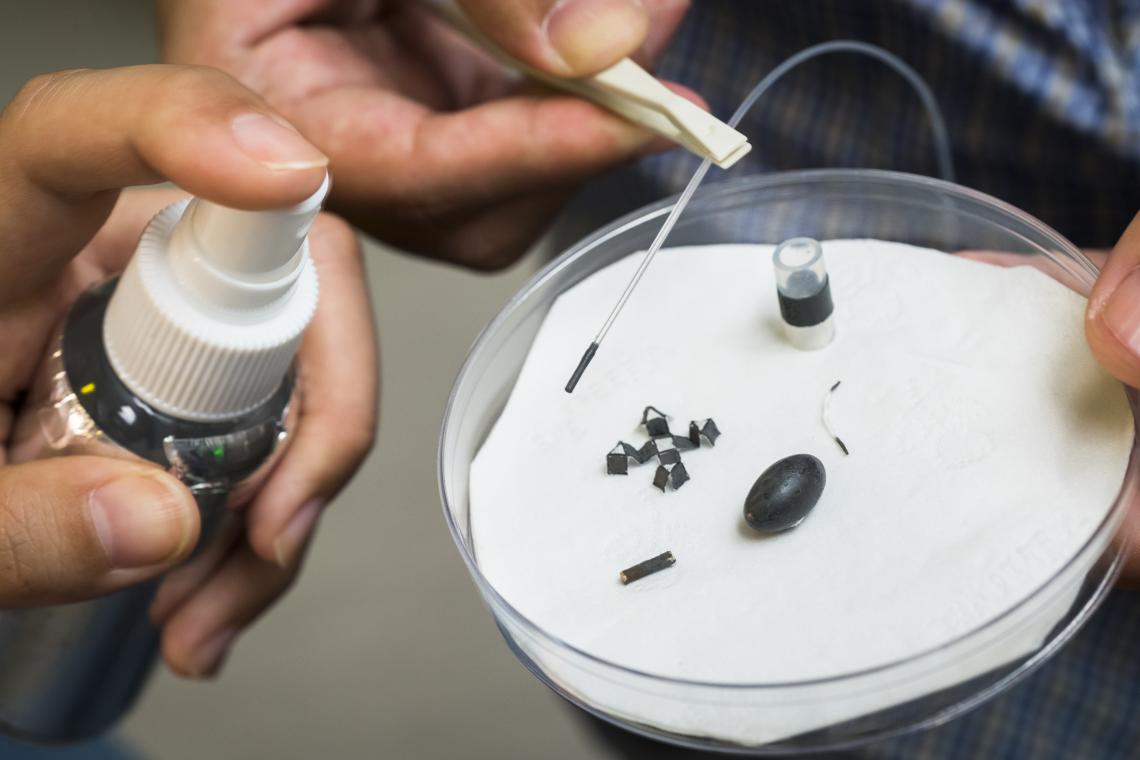Dr Yajing Shen places millirobots coated with the magnetic spray inside a Helmholtz coils system to evaluate their magnetic actuation performance.
This story is featured in the Asia Research News 2021 magazine. Read in ISSUU (above) or full text and images below.
Researchers from City University of Hong Kong (CityU) and their collaborators at the Shenzhen Institute of Advanced Technology and Chinese Academy of Sciences designed a simple way to make insect-sized robots, called millirobots, that adapt to different environments for exploration, remote sensing and biomedical applications. The key is coating objects with a composite, glue-like magnetic spray called M-spray.
“Our idea is that, by putting on this magnetic coat, we can turn any object into a robot and control their locomotion,” says CityU engineer Yajing Shen, who led the research published in the journal Science Robotics. “The M-spray we developed sticks on the targeted object and activates it when driven by a magnetic field.”
Composed of polyvinyl alcohol, gluten and iron particles, M-spray adheres to rough and smooth surfaces of one-, two- and three-dimensional objects instantly, stably and firmly. It forms a 0.1–0.25mm film, which is thin enough to preserve the original size, form and structure of the objects. The researchers then programme the alignment of the magnetic particles in the coating with a strong magnetic field to set how the object will move.
The team converted cotton thread, origami, polydimethylsiloxane (PDMS) film and plastic pipe into soft reptile, multi-foot, walking and rolling robots, respectively.
Different alignments combined with differently shaped objects lead to distinct motions. The team converted cotton thread, flat origami, soft film and plastic pipe into robots that crawl, walk, flip and roll. The robots adapted well to various obstacles and surfaces, including glass, skin, wood and sand.
Notably, a millirobot’s locomotion mode can be reset on demand by reprogramming the alignment of the magnetic particles coating it. For example, the same millirobot could switch from a faster 3D caterpillar movement in a spacious environment to a slower 2D accordion movement for passing through a narrow gap, explains Xiong Yang, a PhD student in Shen’s lab and co-first paper author.
All M-spray components are biocompatible and can disintegrate inside the body when needed, showing potential for biomedical applications. For example, the team demonstrated that a catheter coated with M-spray can make both sharp and smooth turns. They also guided an M-spray-coated capsule containing a drug to a specific location inside a rabbit’s stomach. Once there, an oscillating magnetic field caused the coating to disintegrate, releasing the drug.
“The controllable disintegration property of M-spray enables drugs to be released in a targeted location rather than scattering in the organ,” Shen says.
The team plans to continue improving M-spray’s ability to withstand the acidic environment of the body, broadening its applications in medicine, as well as exploring its use in other fields.
Further information
Associate Professor Yajing Shen
[email protected]
Department of Biomedical Engineering
City University of Hong Kong





